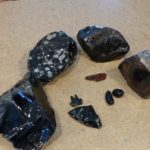Today it’s easy to buy just about anything by touching a few keystrokes. In an amazingly short time, a package from Amazon or another company will arrive. However, it wasn’t always easy to acquire important things. Consider obsidian.
Obsidian is a fascinating rock always formed by volcanic action. It’s essentially natural glass, and a chunk of it shimmers in the hand. It’s usually black but can be brown, tan, green, blue, red, orange or yellow depending on the minerals within it.
Although obsidian is found in natural deposits scattered around the world, in the United States it occurs mostly in Arizona, California, Idaho, Nevada, and Oregon with smaller deposits in New Mexico, Washington, and Wyoming. An entire obsidian hillside is easy to see from the road in Yellowstone National Park just south of Mammoth.
In days long before Amazon shipped packages, obsidian was one of the most precious of commodities. Imagine you are Native American thousands of years ago. Some of this evening’s dinner may come from corn or squash you grew but more likely it would be deer, elk, rabbit or squirrel meat or even a big catfish fillet.
Back then hunting wasn’t recreation. It was a vital source of food, and hunters had to do whatever possible to make catching an animal successful. They spent hours crafting efficient spears long before the bow and arrow were invented. After bows replaced spears Native Americans crafted efficient arrows.
Obsidian was the very best rock to make spear and arrow points from. It fractures into flakes so sharp that it has been used for modern surgical scalpels. It makes beautiful and deadly spear and arrow points.
Most Native Americans had a problem. There was no natural obsidian within hundreds or thousands of miles of their homes. Often, they used flint or chert for points. These worked well, but Obsidian was better. It was a valuable commodity.
Long before history began recording events Native Americans had developed elaborate trade routes across North America. One of the most valuable trade items was obsidian. We live in Iowa, and there are no known natural obsidian deposits. But obsidian arrowheads are relatively common. There’s no doubt that it came here, and throughout most of North America, carried great distances by traders who walked around the continent and swapped it for items they needed.
Modern bowhunters use arrows tipped with razor-sharp steel points, but obsidian is still valued for its beauty and unusual shapes and colors. Today it’s zipped around the world in cars, planes, trucks, and ships. It’s even possible to order it from Amazon.


